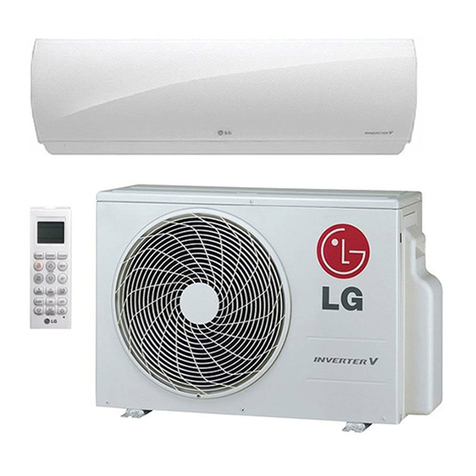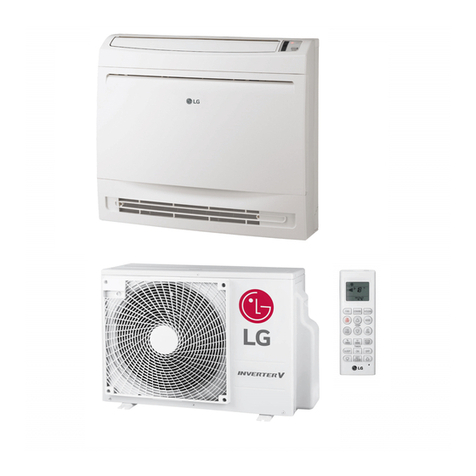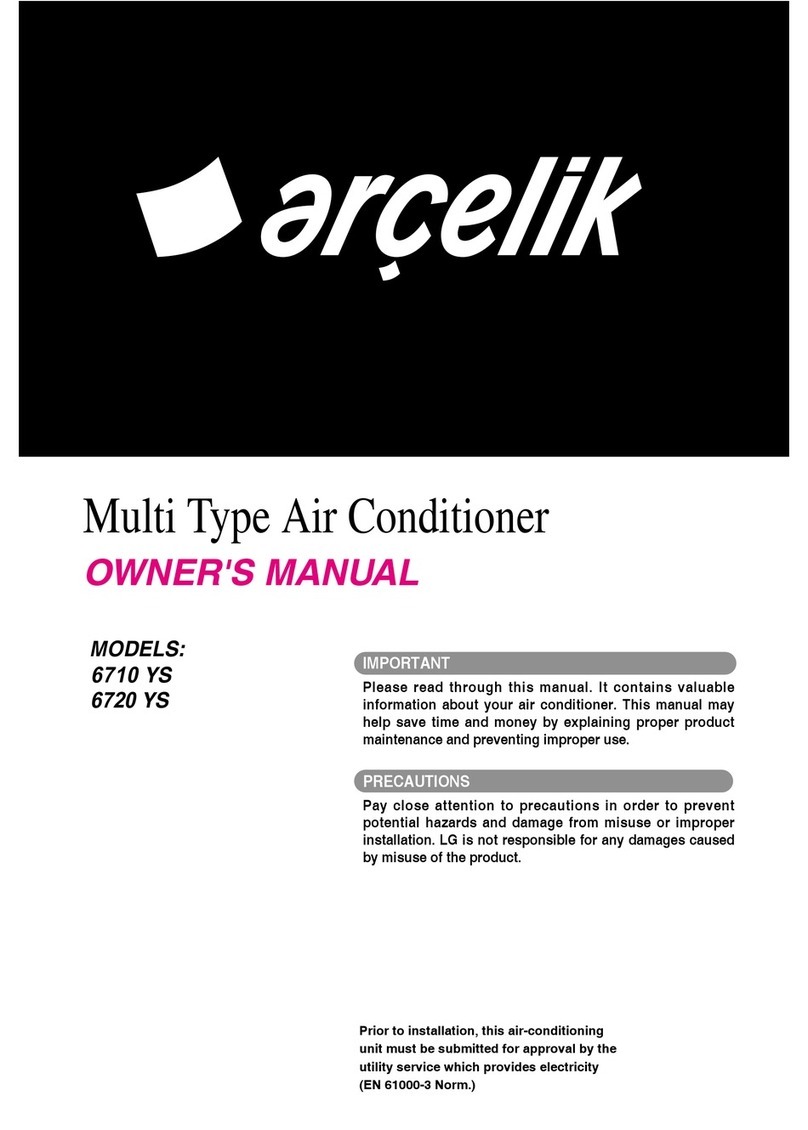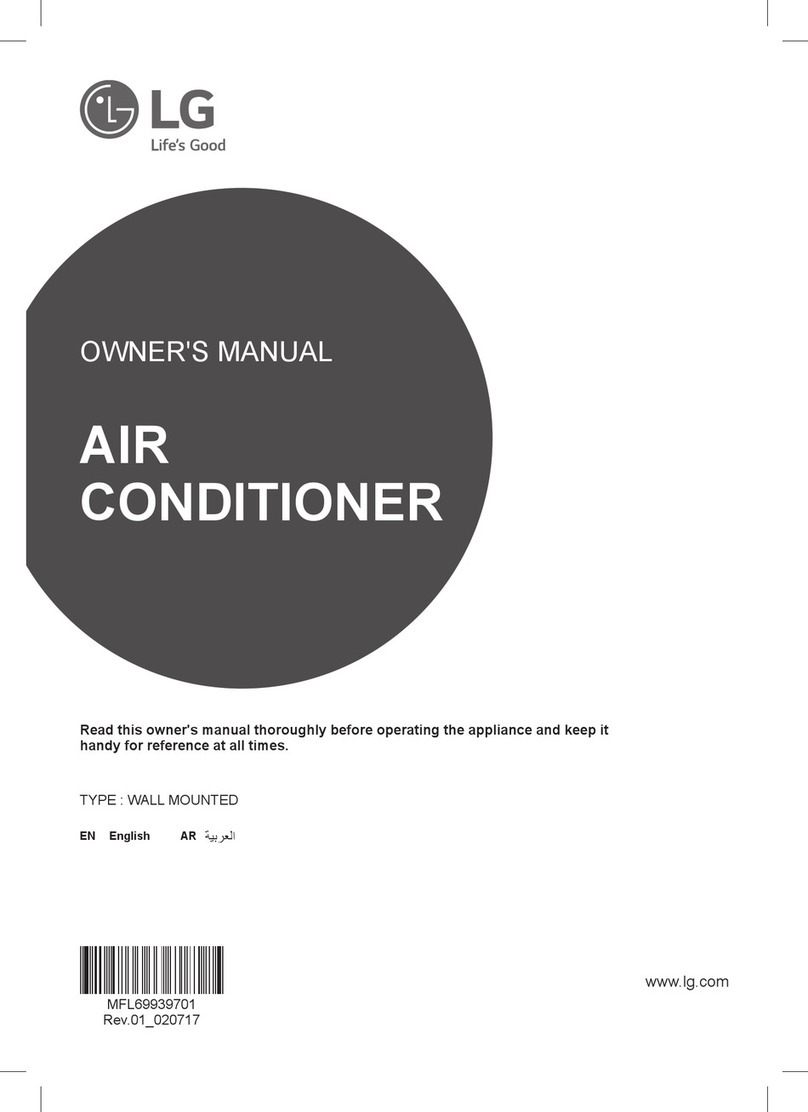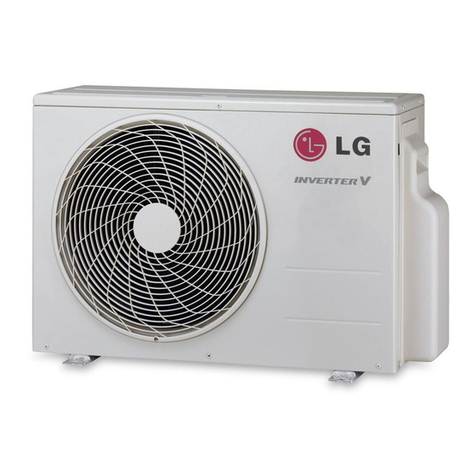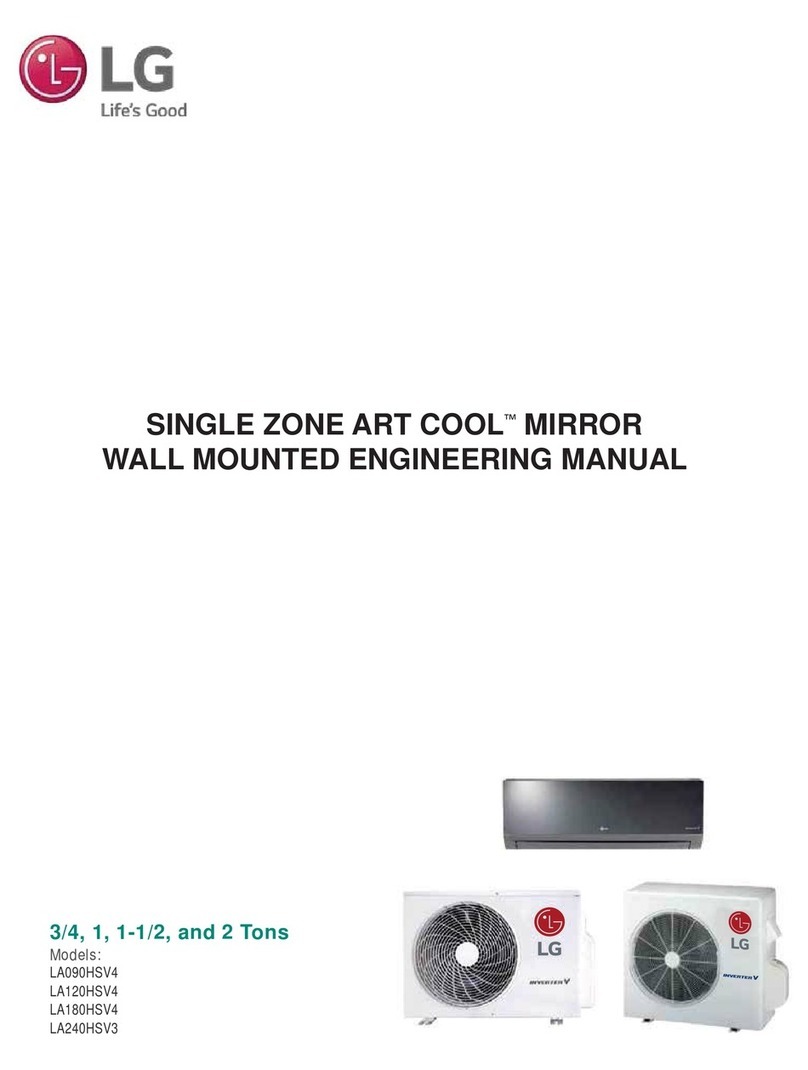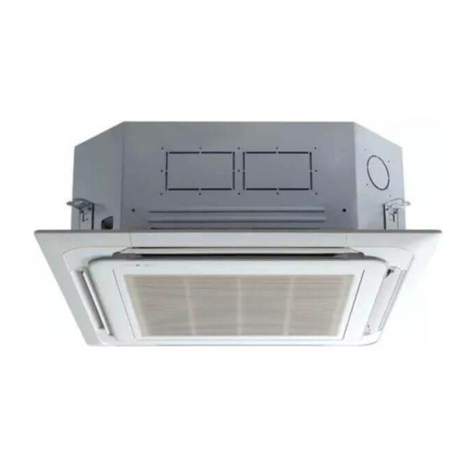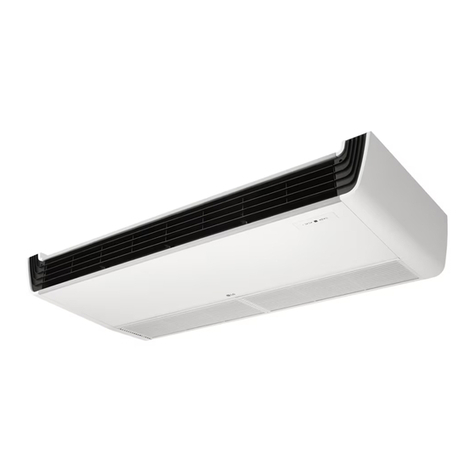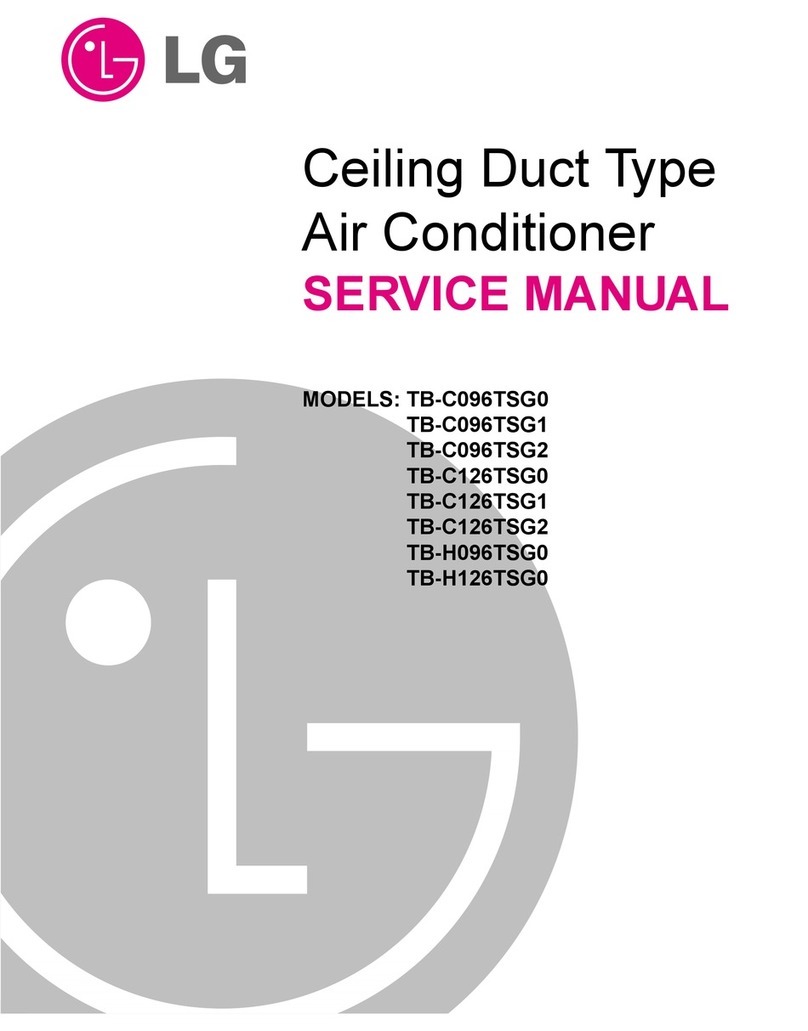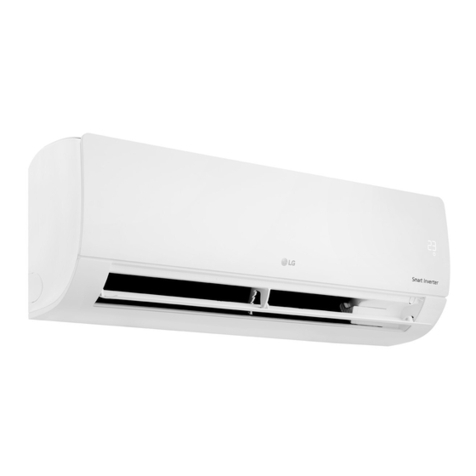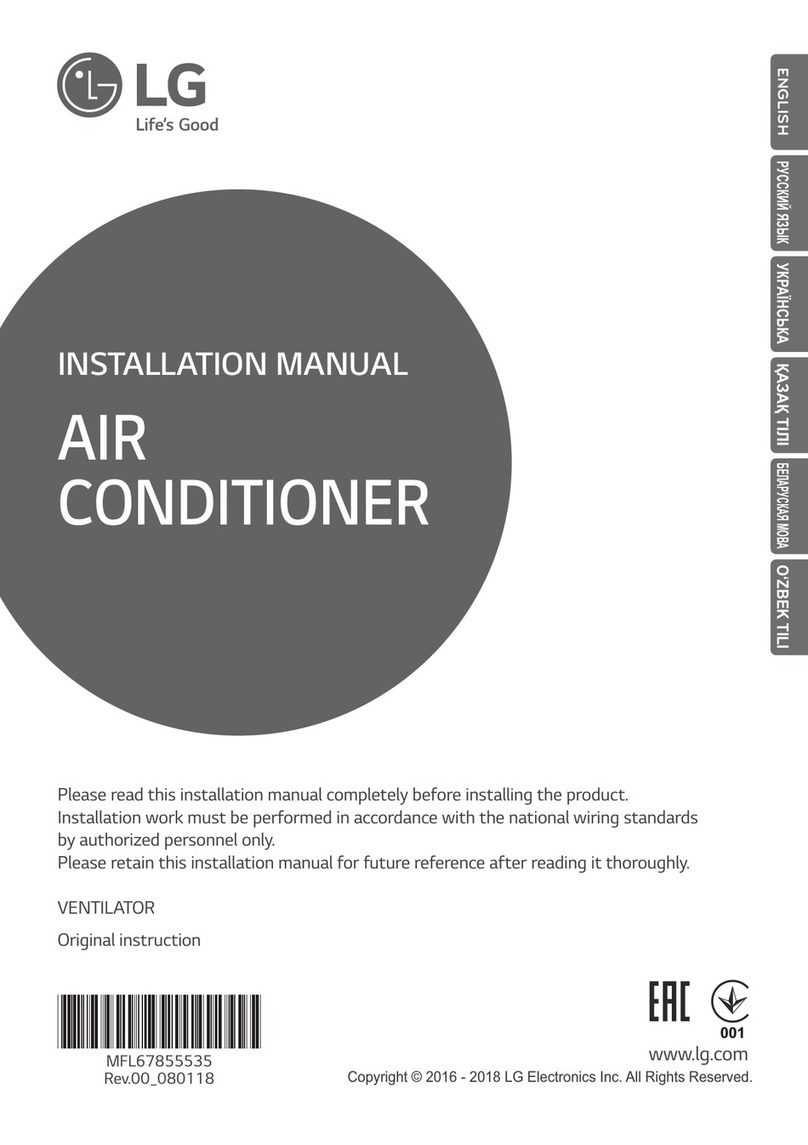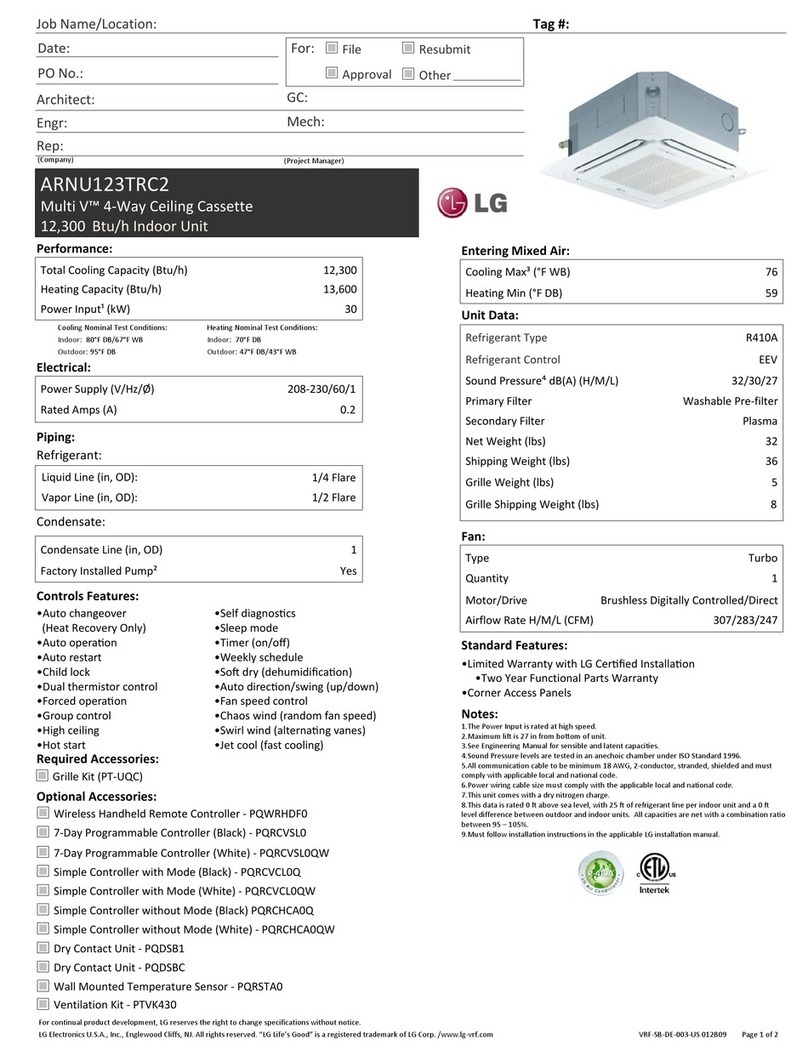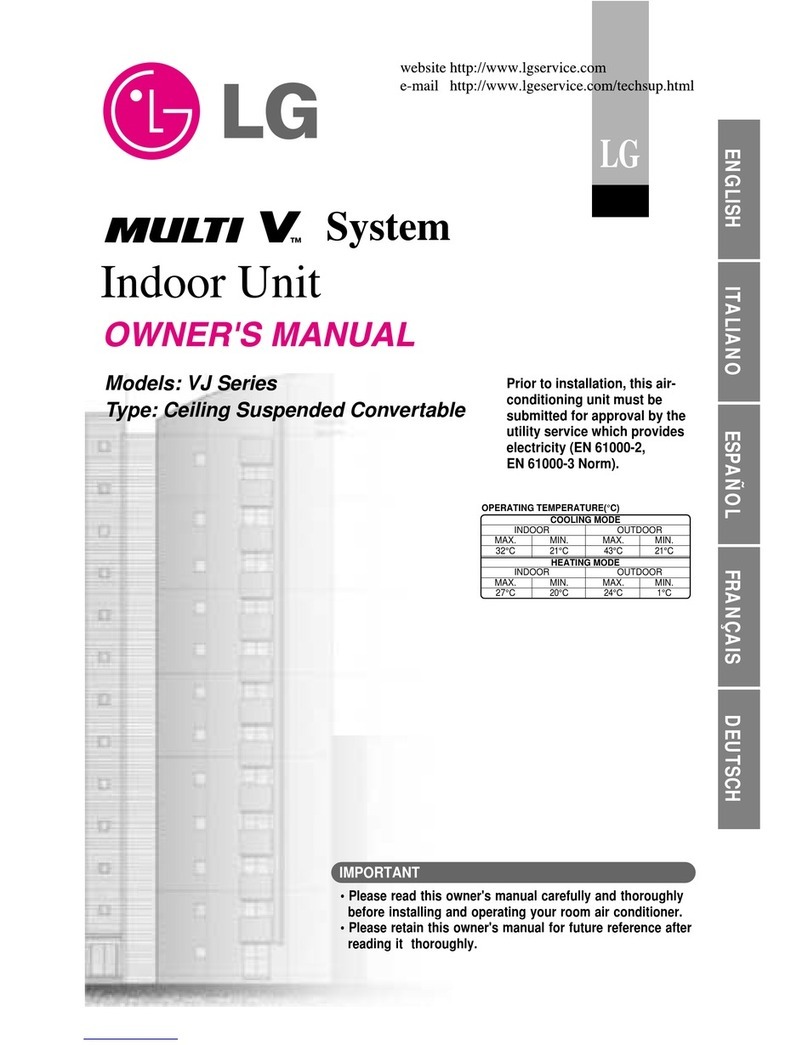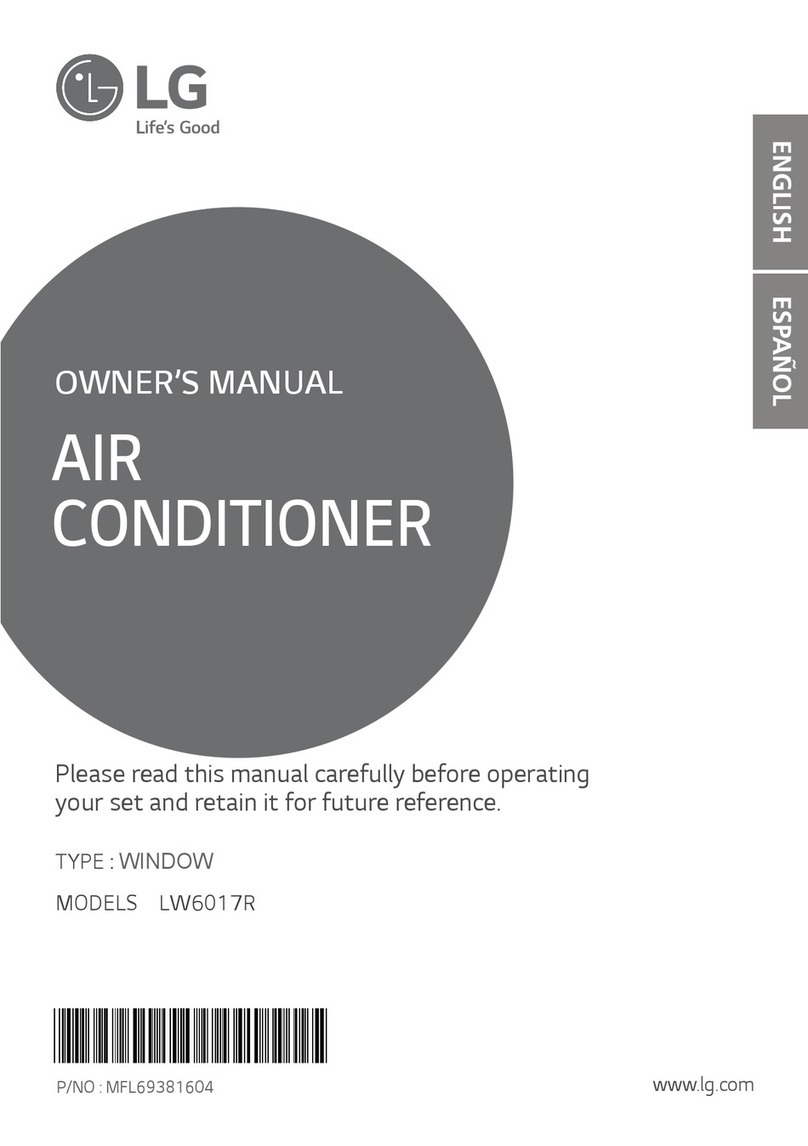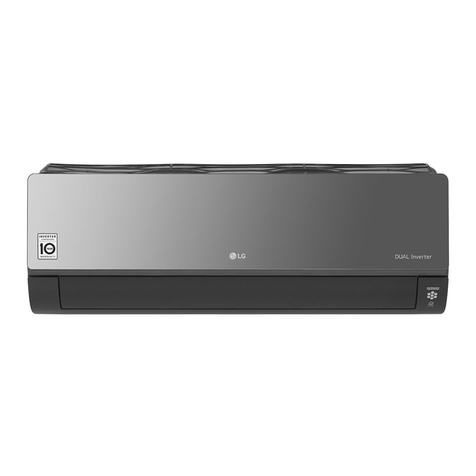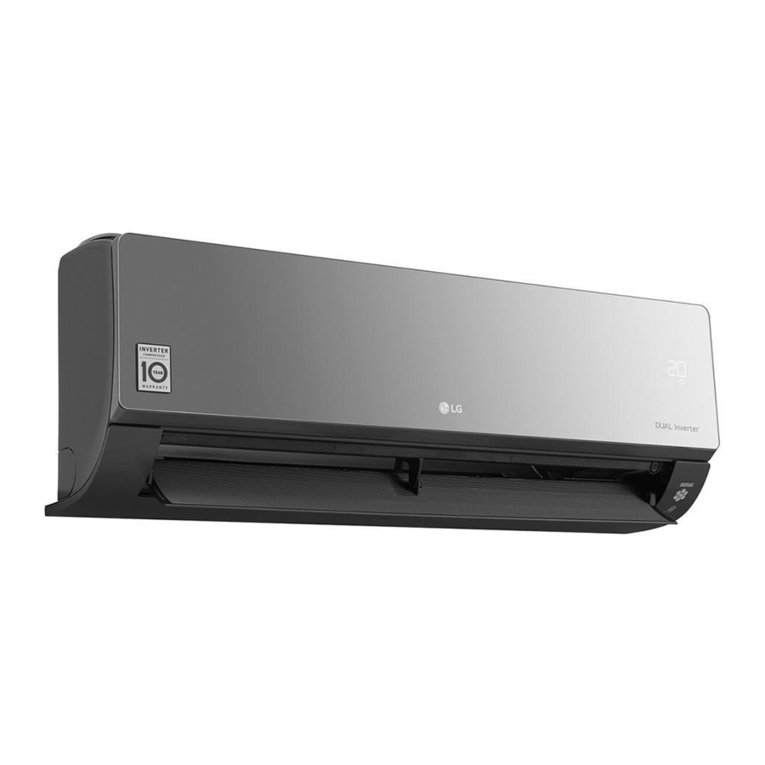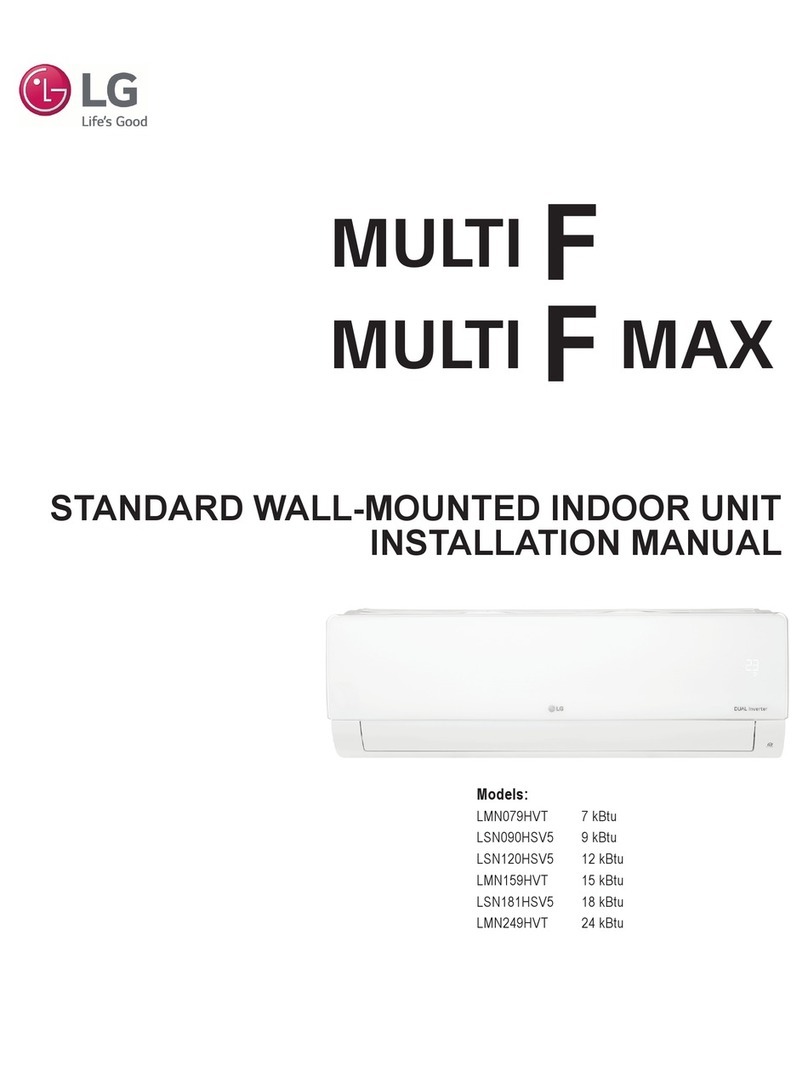
• Do not cool excessively indoors. This may be harmful for your health and may consume more
electricity.
• Block sunlight with blinds or curtains while you are operating the air conditioner.
• Keep doors or windows closed tightly while you are operating the air conditioner.
• Adjust the direction of the air flow vertically or horizontally to circulate indoor air.
• Speed up the fan to cool or warm indoor air quickly, in a short period of time.
• Open windows regularly for ventilation as the indoor air quality may deteriorate if the air condi-
tioner is used for many hours.
• Clean the air filter once every 2 weeks. Dust and impurities collected in the air filter may block the
air flow or weaken the cooling / dehumidifying functions.
For your records
Staple your receipt to this page in case you need it to prove the date of purchase or for warranty
purposes. Write the model number and the serial number here:
Model number :
Serial number :
You can find them on a label on the side of each unit.
Dealer’s name :
Date of purchase :
Here are some tips that will help you minimize the power consumption when you use the air
conditioner. You can use your air conditioner more efficiently by referring to the instructions
below:
TIPS FOR SAVING ENERGY - Otherwise, the expansion valve or capillary tube may become blocked with contaminants.
• For R410A model, use piping, flare nut and tools which is specified for R410A refrigerant.
- Using of (R22) piping, flare nut and tools may cause abnormally high pressure in the refrigerant
cycle (piping), and possibly result in explosion and injury.
• It is desirable that the amount of residual oil less than 40 mg/10 m.
• Do not turn on the breaker or power under condition that front panel, cabinet, top cover, control box
cover are removed or opened.
- Otherwise, it may cause fire, electric shock, explosion or death.
Operation
• Do not share the outlet with other appliances.
- It will cause an electric shock or a fire due to heat generation.
• Do not use the damaged power cord.
- Otherwise, it may cause a fire or electrical shock.
• Do not modify or extend the power cord randomly.
- Otherwise, it may cause a fire or electrical shock.
• Take care so that the power cord may not be pulled during operation.
- Otherwise, it may cause a fire or electrical shock.
• Unplug the unit if strange sounds, smell, or smoke comes from it.
- Otherwise, it may cause electrical shock or a fire.
• Keep the flames away.
- Otherwise, it may cause a fire.
• Take the power plug out if necessary, holding the head of the plug and do not touch it with wet
hands.
- Otherwise, it may cause a fire or electrical shock.
• Do not use the power cord near the heating tools.
- Otherwise, it may cause a fire and electrical shock.
• Do not open the suction inlet of the indoor/outdoor unit during operation.
- Otherwise, it may electrical shock and failure.
• Do not allow water to run into electrical parts.
- Otherwise, it may cause the failure of machine or electrical shock.
• Hold the plug by the head when taking it out.
- It may cause electric shock and damage.
• Never touch the metal parts of the unit when removing the filter.
- They are sharp and may cause injury.
Select the best Location
Indoor unit
- There should not be any heat or steam near
the unit.
- Select a place where there are no obstacles
around of the unit.
- Make sure that condensation drainage can
be conveniently routed away.
- Do not install near a doorway.
- Ensure that the interval between a wall and
the left (or right) of the unit is more than
100mm. The unit should be installed as high
as possible on the wall, allowing a minimum
of 200mm from ceiling.
- Use a metal detector to locate studs to pre-
vent unnecessary damage to the wall.
* The feature can be changed according to a
type of model.
More than 200
More than
100
More than
100
(Unit : mm)
INSTALLATION
More than
300
More than
300
Sunroof
Fence or
obstacles
More than
700
More than
600
(Unit : mm)
Outdoor unit
- If an awning is built over the unit to prevent
direct sunlight or rain exposure, make sure
that heat radiation from the condenser is not
restricted.
- Ensure that the space around the back and
sides is more than 300mm. The space in
front of the unit should be more than 700mm
of space.
- Do not place animals and plants in the path
of the warm air.
- Take the weight of the air conditioner into ac-
count and select a place where noise and vi-
bration are minimum.
- Select a place where the warm air and noise
from the air conditioner do not disturb neigh-
bors.
IMPORTANT SAFETY INSTRUCTIONS
READ ALL INSTRUCTIONS BEFORE USING THE APPLIANCE.
Always comply with the following precautions to avoid dangerous situations and ensure peak
performance of your product.
WARNING
It can result in serious injury or death when the directions are ignored.
CAUTION
It can result in minor injury or product damage when the directions are ignored.
WARNING
• Installation or repairs made by unqualified persons can result in hazards to you and others.
• Air conditioner Shall be installed in accordance with national wiring regulations.
• If the supply cord is damaged, it must be replaced by the manufacturer, its service agent or similary
qualified persons in order to avoid a hazard.
• The information contained in the manual is intended for use by a qualified service technician familiar
with safety procedures and equipped with the proper tools and test instruments.
• Failure to carefully read and follow all instructions in this manual can result in equipment malfunc-
tion, property damage, personal injury and/or death.
Installation
• Always perform grounding.
- Otherwise, it may cause electrical shock.
• Don’t use a power cord, a plug or a loose socket which is damaged.
- Otherwise, it may cause a fire or electrical shock.
• For installation of the product, always contact the service center or a professional installation
agency.
- Otherwise, it may cause a fire, electrical shock, explosion or injury.
• Securely attach the electrical part cover to the indoor unit and the service panel to the outdoor unit.
- If the electrical part cover of the indoor unit and the service panel of the outdoor unit are not
attached securely, it could result in a fire or electric shock due to dust, water, etc.
• Always install an air leakage breaker and a dedicated switching board.
- No installation may cause a fire and electrical shock.
• Do not keep or use flammable gases or combustibles near the air conditioner.
- Otherwise, it may cause a fire or the failure of product.
• Ensure that an installation frame of the outdoor unit is not damaged due to use for a long time.
- It may cause injury or an accident.
• Do not disassemble or repair the product randomly.
- It will cause a fire or electrical shock.
• Do not install the product at a place that ther is concern of falling down.
- Otherwise, it may result in personal injury.
• Use caution when unpacking and installing.
- Sharp edges may cause injury.
• Thickness of copper pipes used are as shown “Flaring work” Table.
- Never use copper pipes thinner than that in the table even when it is available on the market
• Do not use copper pipes having a collapsed.
!
!
!
• Do not step on the indoor/outdoor unit and do not put anything on it.
- It may cause an injury through dropping of the unit or falling down.
• Do not place a heavy object on the power cord.
- Otherwise, it may cause a fire or electrical shock.
• When the product is submerged into water, always contact the service center.
- Otherwise, it may cause a fire or electrical shock.
• Take care so that children may not step on the outdoor unit.
- Otherwise, children may be seriously injured due to falling down.
CAUTION
Installation
• Install the drain hose to ensure that drain can be securely done.
- Otherwise, it may cause water leakage.
• Install the product so that the noise or hot wind from the outdoor unit may not cause any damage to
the neighbors.
- Otherwise, it may cause dispute with the neighbors.
• Always inspect gas leakage after the installation and repair of product.
- Otherwise, it may cause the failure of product.
• Keep level parallel in installing the product.
- Otherwise, it may cause vibration or water leakage.
Operation
• Avoid excessive cooling and perform ventilation sometimes.
- Otherwise, it may do harm to your health.
• Use a soft cloth to clean. Do not use wax, thinner, or a strong detergent.
- The appearance of the air conditioner may deteriorate, change color, or develop surface flaws.
• Do not use an appliance for special purposes such as preserving animals vegetables, precision
machine, or art articles.
- Otherwise, it may damage your properties.
• Do not place obstacles around the flow inlet or outlet.
- Otherwise, it may cause the failure of appliance or an accident.
!
INSTALLATION TOOLS
INSTALLATION PARTS
Name Quantity Shape
Installation plate 1 EA
Type "A" screw
5 EA
Type "B" screw
Type "B" screw
2 EA
Type "C" screw
2 EA
Remote control
holder
1 EA
The feature can be changed according a type of model.
The feature can be changed according a type of model.
Screws for fixing panels are attached to decoration panel.
Figure FigureName
Screw driver
Electric drill
Measuring tape, Knife
Hole core drill
Spanner
Torque wrench
Multi-meter
Hexagonal wrench
Ammeter
Gas-leak detector
Thermometer,
Level
Flaring tool set
Name
Fixing Installation Plate
The wall you select should be strong and solid
enough to prevent vibration.
1
Before installation, confirm the chassis name
on the box of indoor unit.
2Mount the installation plate on the wall
with type "A" screws. If mounting the unit
on a concrete wall, use anchor bolts.
- Mount the installation plate horizontally
by aligning the centerline using Horizontal
meter .
3Measure the wall and mark the centerline.
It is also important to use caution concern-
ing the location of the installation plate.
Routing of the wiring to power outlets is
through the walls typically. Drilling the hole
through the wall for piping connections
must be done safely.
Chassis
Hook
Type “A”
Installation Plate
Ø65 Ø65
Right Rear
Piping
Left Rear
Piping
Installation Plate
Place a level on raised tab
(Unit : mm) 75
229 15
22815
180
462 465
SN CHASSIS
Unit Outline
Unit bottom
Line
Drill a Hole in the Wall
- Drill the piping hole with a ø65mm hole core
drill. Drill the piping hole at either the right or
the left with the hole slightly slanted to the
outdoor side.
Flaring Work
Main cause for gas leakage is due to defect of
flaring work. Carry out correct flaring work in
the following procedure.
Cut the pipes and the cable
1Use the piping kit accessory or the pipes
purchased locally.
2Measure the distance between the indoor
and the outdoor unit.
3Cut the pipes a little longer than measured
distance.
4Cut the cable 1.5m longer than the pipe
length.
5-7mm
(3/16"~5/16")
Indoor
WALL
Outdoor
Copper
pipe
90°
Slanted Uneven Rough
INSTALLATION MAP
Saddle
Tapping Direction
Vinyl tape (Wide)
• Apply after carrying out a
drainage test.
• To carry out the drainage
test, remove the air filters
and pour water into the heat
exchanger.
Installation plate
Sleeve
Bushing-Sleeve
Putty(Gum Type Sealant)
Bend the pipe as closely
on the wall as possible,
but be careful that it
doesn't break.
Connecting cable
(Optional Parts)
Gas side piping
(Optional Parts)
Liquid side piping
(Optional Parts)
Additional drain pipe
Vinyl tape (Narrow)
Drain Hose
NOTE
!
• You should purchase the installation parts.
* The feature can be changed according to a type of model.
Bar
Copper pipe
Clamp handle Red arrow mark
Cone
Yoke
Handle
Bar
"A"
Inclined
Inside is shiny without scratches
Smooth all round
Even length
all round
Surface
damaged
Cracked Uneven
thickness
= Improper flaring =
Burrs removal
1. Completely remove all burrs from the cut
cross section of pipe/tube.
2. While removing burrs put the end of the
copper tube/pipe in a downward direction
while removing burrs location is also
changed in order to avoid dropping burrs
into the tubing.
Putting nut on
- Remove flare nuts attached to indoor and
outdoor unit, then put them on pipe/tube
having completed burr removal.
(not possible to put them on after finishing
flare work)
Flaring work
1Firmly hold copper pipe in a bar with the di-
mension shown in below table table
below.
2Carry out flaring work with the flaring tool.
Check
1Compare the flared work with the figure
by.
2If a flared section is defective, cut it off
and do flaring work again.
Connecting the Piping
1Open the front panel.
- Lift up the left(right) section of front panel
carefully.
- Lift up the center section of front panel
carefully.
Flare nut
Copper tube
Outside diameter A Thickness
mm inch mm mm
Ø6.35 1/4" 1.1~1.3 0.7
Ø9.52 3/8" 1.5~1.7 0.8
Ø12.7 1/2" 1.6~1.8 0.8
Ø15.88 5/8" 1.6~1.8 1.0
Ø19.05 3/4" 1.9~2.1 1.0
Installation of Indoor Unit
1Hook the indoor unit onto the upper por-
tion of the installation plate.( engage the
three hooks at the top of the indoor unit
with the upper edge of the installation
plate) Ensure that the hooks are properly
seated on the installation plate by moving
it left and right
2Unlock the tubing holder from the chassis
and mount between the chassis and instal-
lation plate in order to separate the bottom
side of the indoor unit from the wall.
* The feature can be changed according to a
type of model.
Piping
1Insert the connecting cable through the
bottom side of indoor unit and connect the
cable (You can see detail contents in 'Con-
necting the cables' section)
<Left side piping>
<Right side piping>
2Secure the cable onto the control board
with the cable retainer.
3Tape the tubing pipe, drain hose and the
connection cable. Be sure that the drain
hose is located at the lowest side of the
bundle. Locating at the upper side can
cause overflow from the drain pan through
the inside of the unit.
<Left side piping>
<Right side piping>
* The feature can be changed according a
type of model.
View
Terminal block
Connecting cable
Cable retainer
1
2Installation plate
Tubing Holder
View
Terminal block
Connecting cable
Cable retainer
Drain hose Connecting pipe
Connecting
cable
Ta p e
Drain hose
Connecting pipe
Connecting
cable
Ta p e
Drain hose
Finishing the indoor unit
installation
1Mount the tubing holder in the original
positon.
2Ensure that the hooks are properly seated
on the installation plate by moving it left
and right.
3Press the lower left and right sides of the
unit against the installation plate until the
hooks engage into their slots (clicking
sound).
4Finish the assembly by screwing the unit
to the installation plate by using two pieces
of type "C" screws. And assemble a chas-
sis cover.
Type 'C' screw
Outdoor unit
Connecting the Piping
- Remove the tubing cover from the unit by
loosening the screw.
- Align the center of the pipings and suffi-
ciently tighten the flare nut by hand.
CAUTION
Do not block the hole of air sensor when
using piping cover.
!
NOMINAL CROSSSEC-
TIONAL AREA
Grade
2.5~3.5kW
(9~12k)
1.0
(mm2)
Cord clamp
Terminal block
Wiring
diagram
Tubing
cover
Air
Conditioner
Main power source
Circuit Breaker
Use a circuit breake
or time delay fuse.
The power connecting cable with indoor and
outdoor unit should be selected according to
the following national wiring regulations.
The supply cords of parts of appliances for
outdoor use shall not be lighter than poly-
chloroprene sheathed flexible cord. (code des-
ignation 60245 IEC 57, H05RN-F)
* Field wiring shall be done such that the cur-
rentcarrying conductors become taut before
the earthing conductor if the cord slips out
of the cord anchorage.
- Connect the wires to the terminals on the
control board individually.
- Secure the cable onto the control board with
the cord clamp.
- Use a recognized circuit breaker between
the power source and the unit.
A disconnecting device to adequately discon-
nect all supply lines must be fitted.
Cortacircuitos (A)
Capacity
2.5~3.5kW (9~12k)
15
CAUTION
Provide the circuit breaker between
power source and the unit as shown by
!
Outdoor unit
Good case
- Press on the tubing cover and unfold the
tubing to downward slowly. And then bend
to the left side slowly.
3Pull back the tubing holder.
4Remove pipe port cover and positioning
the tubing
* The feature can be changed according to a
type of model.
* The feature can be changed according to a
type of model.
Bad case
- Following bending case from right to left di-
rectly may cause damage to the tubing.
Right
Indoor unit back side view
Tubing holder
Backwards
Left
CAUTION
Installation Information. For right piping.
Follow the instruction above.
!
2Remove the chassis cover from the unit by
loosing 4 screws
NOTE
!
It may be hard to open the front panel be-
cause of big torque of stepping motor.
Gas Pipe Liquid Pipe
Cutting Line
Cutting Line
Good Case Bad Case
* Tubing cutting line have to be upward.
Vinyl tape(narrow)
Connection pipe
Connecting cable
Vinyl tape (wide) Wrap with vinyl tape
Indoor unit pipe
Pipe
Wrap with vinyl tape
Drain hose
Pipe
Vinyl tape(wide)
Indoor unit tubing Flare nut Pipes
Wrap the insulation material
around the connecting portion.
1Overlap the connection pipe insulation ma-
terial and the indoor unit pipe insulation
material. Bind them together with vinyl
tape so that there may be no gap.
2Set the tubing cutting line upward.
Wrap the area which accommodates the
rear piping housing section with vinyl tape.
3Bundle the piping and drain hose together
by wrapping them with vinyl tape sufficient
enough to cover where they fit into the
rear piping housing section.
Wrench
Indoor unit tubing
Open-end wrench
(fixed)
Connection
pipe
Flare nut
Vinyl tape(narrow)
Adhesive
Drain pipe
Indoor unit drain hose
Outside Diameter Torque
mm inch kgf·cm N·m
Ø6.35 1/4 180~250 17.6~24.5
Ø9.52 3/8 340~420 33.3~41.2
Ø12.7 1/2 550~660 53.9~64.7
Ø15.88 5/8 630~820 61.7~80.4
Connecting the installation pipe
and drain hose to the indoor unit.
1Align the center of the pipes and suffi-
ciently tighten the flare nut by hand
2Tighten the flare nut with a wrench
3. When needed to extend the drain hose of
indoor unit, assembly the drain pipe as
shown on the drawing
The power cord connected to unit should
be selected according to the following na-
tional wiring regulations.
The supply cords of parts of appliances for
outdoor use shall not be lighter than poly-
chloroprene sheathed flexible cord. (code
designation 60245 IEC 57, H05RN-F)
NOMINAL CROSSSEC-
TIONAL AREA
Grade
2.5~3.5kW
(9~12k)
1.0
(mm2)
CAUTION
!
Connecting the Cables
Indoor unit
Connect the cable to the indoor unit by con-
necting the wires to the terminals on the con-
trol board individually according to the outdoor
unit connection. (Ensure that the color of the
wires of the outdoor unit and the terminal No.
are the same as those of the indoor unit.)
- Finally, tighten the flare nut with torque
wrench until the wrench clicks.
When tightening the flare nut with torque
wrench, ensure the direction for tightening
follows the arrow on the wrench.
Outdoor unit
Gas side piping
(Bigger diameter)
Liquid side piping
(Smaller diameter)
Torque wrench
CAUTION
- The circuit diagram is a subject to
change without notice.
- The earth wire should be longer than the
common wires.
- When installing, refer to the circuit dia-
gram on the front grille.
- Connect the wires firmly so that they
may not be pulled out easily.
- Connect the wires according to color
codes, referring to the wiring diagram.
!
Outside Diameter Torque
mm inch kgf·cm N·m
Ø6.35 1/4 180~250 17.6~24.5
Ø9.52 3/8 340~420 33.3~41.2
Ø12.7 1/2 550~660 53.9~64.7
Ø15.88 5/8 630~820 61.7~80.4
CAUTION
According to the confirmation of the
above conditions, prepare the wiring as
follows.
1Never fail to have an individual power
circuit specifically for the air condi-
tioner. As for the method of wiring, be
guided by the circuit diagram posted
on the inside of control cover.
2The screw which fasten the wiring in
the casing of electrical fittings are li-
able to come loose from vibrations to
which the unit is subjected during the
course of transportation. Check them
and make sure that they are all tightly
fastened. (If they are loose, it could
cause burn-out of the wires.)
3Specification of power source.
4Confirm that electrical capacity is suffi-
cient.
5See that the starting voltage is main-
tained at more than 90 percent of the
rated voltage marked on the name
plate.
6Confirm that the cable thickness is as
specified in the power source specifi-
cation.
(Particularly note the relation between
cable length and thickness.
7Always install an earth leakage circuit
breaker in a wet or moist area.
8The following would be caused by volt-
age drop.
- Vibration of a magnetic switch, which
will damage the contact point, fuse
breaking, disturbance of the normal
function of the overload.
9The means for disconnection from a
power supply shall be incorporated in
the fixed wiring and have an air gap
contact separation of at least 3mm in
each active(phase) conductors.
!Checking the Drainage
To check the drainage.
1Pour a glass of water on the evaporator.
2Ensure the water flows through the drain
hose of the indoor unit without any leak-
age and goes out the drain exit.
Drain piping
1The drain hose should point downward for
easy drain flow.
Drain Pan
Drain Hose
Leakage
Checking
Connecting area
drain hose
Leakage
checking
1 2 3
54 6 7
INSTALLATION MANUAL AIR CONDITIONER
TYPE : WALL MOUNTED
P/No : MFL68124704
